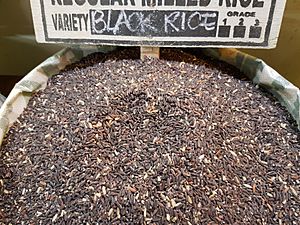Black rice facts for kids
Black rice, also called purple rice, is a special kind of rice. It comes from the plant Oryza sativa. Some types of black rice are also glutinous rice, which means they become sticky when cooked.
This unique rice is known for its deep, dark color. When you cook it, black rice often turns a beautiful deep purple.
Contents
What Makes Black Rice Special?
Black rice gets its amazing dark color from something called anthocyanins. These are natural pigments, like the ones that make blueberries and blackberries purple. Black rice has more anthocyanins than many other colored grains.
The outer layer of black rice, called the bran hull, is packed with these healthy anthocyanins. This rice also has a good amount of fiber, similar to brown rice. It has a mild, slightly nutty taste that many people enjoy.
Where Does Black Rice Come From?
There are many different kinds of black rice grown around the world. Some popular types include:
- Indonesian black rice
- Philippine balatinaw black rice, which is an heirloom variety (meaning it's an old, special type passed down through generations)
- Philippine pirurutong black glutinous rice
- Thai jasmine black rice
In Manipur, India, black rice is known as chak-hao. In Bangladesh, people call it kalo dhaner chaal, which means "black paddy rice."
How Is Black Rice Used?
Black rice is very versatile in the kitchen. People use it to make all sorts of delicious dishes, including:
- Warm porridge
- Sweet desserts
- Traditional Chinese black rice cakes
- Different kinds of bread
- Tasty noodles
Its unique color and nutty flavor make it a favorite ingredient in many cuisines.
Nutrition Facts About Black Rice
Black rice is not just pretty; it's also good for you! Here's a quick look at some of the nutrients you can find in 100 grams of cooked black rice:
| Nutrient | Amount | Unit |
|---|---|---|
| Energy | 356 | kcal |
| Protein | 8.89 | g |
| Total fat | 3.33 | g |
| Carbohydrates | 75.56 | g |
| Dietary fiber | 2.2 | g |
| Iron | 2.4 | mg |
As you can see, it provides energy, protein, and fiber, which are all important for a healthy body.
See also
 In Spanish: Arroz negro (variedad) para niños
In Spanish: Arroz negro (variedad) para niños




